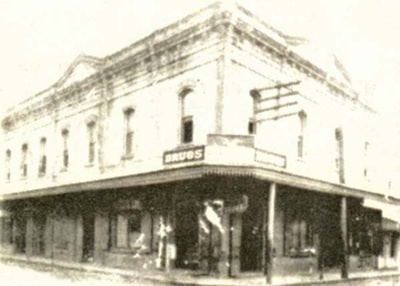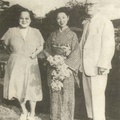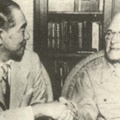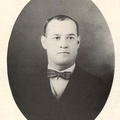Early Childhood
Fred Kinzaburo Makino was born on August 28, 1877 in Yokohama, Japan. His father, Joseph Higgenbotham, was a merchant/trader from Manchester, England. His mother was Kin Makino from Kanagawa Perfecture, Japan. His father died in September 1881, when Kinzaburo was only 4 years old. Although children of mixed marriages were rare in the Japan of the 1880s, Makino was able to grow up without too many problems, thanks to his mother’s warm love and to the fact that Yokohama was an international port city with more than its share of foreigners.
Not much is known about Kinzaburo’s formal schooling, aside from his ability to read, write and speak both English and Japanese.
When Kinzaburo—the third son—was 20 years old, his eldest brother, Jo Makino, was already operating a store in Naalehu on the Big Island. It was located in a place called “Makino Camp,” which consisted of several properties. Kinzaburo’s second brother, Eijiro, was a businessman in Yokohama who maintained a thriving import/export business. Kinzaburo also had two younger sisters and one younger brother, Seiichi Tsuchiya.
Tsuchiya noted that Kinzaburo was a very warm-hearted brother who took good care of his younger sisters and brother. But, on the other hand, Kinzaburo also frequented the judo gym and was known to be a good fighter. He also took lessons in nagauta, a traditional Japanese song which was especially popular at the time. He learned that well, as he did everything else.
According to Tsuchiya, head clerks of import/export houses in Yokohama were reputed to be wealthy. Thus, whenever Kinzaburo, the head clerk of his brother’s establishment, went to a restaurant or a geisha house, he always had a good time. The fun-loving young man was able to sing, do little tricks, etc., which made him popular among the geisha girls. This affinity eventually led to his departure for Hawaii. One day, Kinzaburo, along with his Japanese and foreign friends, went to the Yoshiwara “red light district,” where he was involved in an incident that caught the attention of The Yorozu Cho-ho, then the largest newspaper in Yokohama.
Kinaaburo’s brother, Eijiro, read the article and realized that Kinzaburo was very spoiled and happy-go-lucky. Perhaps he should gain some real-life experience in Hawaii, thought Eijiro. So he sent Kinzaburo to Hawaii to live with their eldest brother, Jo.
Arrival in Hawaii
Kinzaburo was 21 years old when he arrived in Honolulu on April 10, 1899. Upon arrival, he immediately went to Naalehu to work at his brother’s general store. Soon after, he went to work for the Kona Sugar Company as a bookkeeper.
In 1901, he left the Big Island and moved to Honolulu, where he opened the Makino Drug Store at the corner of Nuuanu Avenue and Hotel Street. His brother, Eijiro, is presumed to have helped him financially. He married Michie Okamura in April 1903. At about the same time, he opened a “law office” above his drug store. Kinzaburo did not have a law degree, so his could not legitimately be termed a law office. At the time, however, Japanese immigrants faced many immigration, marital and other legal problems, and since there were no Japanese lawyers, Makino served as a consultant for them.
Before the Japan-U.S. agreement was enacted in 1907, which prohibited Japanese workers from traveling from Hawaii to the Mainland on chartered ships in cooperation with Hoga Kosaka.
The First Japanese Strike
Beginning about mid-1908, some of the Japanese sugar plantation workers began to voice discontentment over their low wages. On December 1, 1908, they organized The Higher Wage Association to push for a pay raise. On May 8, 1009, they struck the Aiea Plantation. The strike quickly spread to other plantations on Oahu, and did not end until August 5—almost three months later.
During the strike, Kinzaburo was elected president of the Higher Wage Association. He worked day and night. His official role was to negotiate with Hawaii Sugar Planters Association (HSPA), but his actual struggle was against the Honolulu Advertiser and the Honolulu Star-Bulletin, the two English daily newspapers, as well as the Hawaii Shimpo and the Hawaii Nichinichi Shimbun, two Japanese newspapers, which sided with the HSPA. He also argued against the territorial government and Japanese Consul-General Senichi Ueno, who was stationed in Honolulu, at the time.

Makino and three others were jailed during the 1909 strike against the sugar planters. Front row: Yokichi Tasaka and Yasutaro Soga; Back row: Genshi Negoro and Kinzaburo Makino
Kinzaburo’s only newspaper ally was The Nippu Jiji, published by Yasutaro Soga. And he had the support of the workers on the plantation, as well as the silent majority of Japanese who lived in Honolulu. Still, he faced an uphill battle. The strike eventually ended without any settlement being reached with the HSPA. However, in November of 1909, the HSPA agreed to the pay raise demands of the workers. Thus, the original purpose of the strike had been achieved.
But the HSPA and the authorities, fearing repercussions from the strike, filed a complaint on various charges which led to the arrests of more than dozen people. Among them, Kinzaburo Makino, Tomoyuki Negoro, Yasutaro Soga and Yokichi Tasaka were found guilty of conspiring to hinder plantation operations. They were sentenced to 10 months in prison and fined $300. The four appealed the verdict, but the territorial Supreme Court upheld their conviction on March 20, 1910 and immediately ordered them to prison. Less than four months later, on July 4, 1910, they were pardoned and set free.
* This article was originally published by the Hawaii Hochi in commemoration of The Hawaii Hochi, Ltd’s 75th Anniversary.
© 1987 Hawaii Hochi, Ltd.








